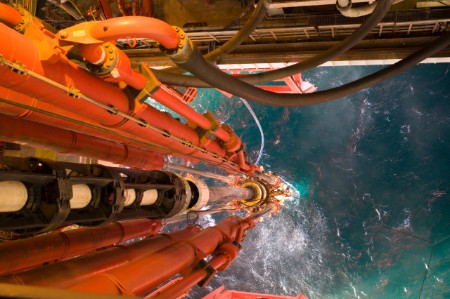
Chapter 1
The potential of AI
Artificial intelligence is transforming the way we interact with the world.
Before assessing its potential impact on the oil and gas sector, it’s important to stress that AI is not just one algorithm, tool, platform or process. Rather it is an ecosystem of technologies and capabilities, each of which is able to replace or augment certain human competencies. These capabilities can be broken down into three key processes:
1. Sensing
AI can emulate human cognitive abilities, and therefore augment or replace them under the right conditions. In some cases, AI can detect patterns in sensory data that reveal signals beyond the boundaries of normal human perception, or in areas people would not typically be able to access. For example, sensors embedded in a storage tank may be able to recognize concentrations of different chemical elements stored in the tank. This type of data can then be fed to a machine learning model to evaluate the impact of those elements on the health and durability of the tank. Insights from such a monitoring system can help prevent accidents or scenarios that expose workers to hazardous environments.
Companies can also use sensing to determine where to drill. For example, geophones are ultrasensitive devices that send sound waves into the earth and record rebouncing ones. Deep learning is then applied to this data to generate reservoir predictions and mitigate risks and potentially reduce drilling costs.
2. Thinking
AI tools can not only analyze and process large data sets faster than traditional statistical approaches, but can also identify patterns in the data that would escape human analysts, developing better insights faster. An intelligent system enabled with computer vision, for example, could automate the process of identifying and tracking the movement of personnel around worksites, helping to optimize safety, identify opportunities for training and improve efficiency.
Elsewhere, smart assistants with conversational interfaces can use machine learning and natural language processing to help enhance the human decision-making process, helping less experienced workers tap into the pooled expertise of an entire industry. This can cover anything from predicting well performance to extracting relevant market insights from technical papers or investor presentations.
3. Acting
AI can increasingly perform tasks that were previously the exclusive domain of humans, freeing them up for higher-value activities that leverage empathy and creativity. An intelligent system, moreover, not only would perform these tasks, but can automate them with little to no human involvement, achieving exponentially higher efficiency. Additionally, AI can streamline decision-making, simplifying the process and even eliminating human involvement altogether. By allowing employees to focus on high value optimization activities, AI creates capacity gains and sets up companies for future growth.
For example, algorithmic controls can be used to optimize an aspect of the fracking process — perforation cluster performance fracking. The algorithms enable consistent execution and better distribution of fluids, removing the need for manual changes to the frac pumps.
Together, these kinds of AI tools can provide organizations with new ways to understand and interact not only with data, but with both their workforce and their physical assets. AI creates a new art of the possible for stakeholders to solve problems, unlock value, and inspire new ways of doing business.

Chapter 2
Why oil and gas needs AI — and how to make the most of it
Embracing new technology can help oil and gas companies address age-old problems around efficiency and talent.
The oil and gas sector is in a challenging position. It must contend with volatile prices, new competitors emerging in the energy sector, and increasing global pressure from both public and private stakeholders around sustainability and environmental issues.
These challenges are all surmountable with the right approaches. Today there are already examples of companies addressing them by embracing AI to find new ways to make the most of their data, assets and people.
Challenge 1: stemming the brain drain
Loss of talent is a significant challenge for the oil and gas sector as a whole. Oil and gas has an aging workforce with many key workers nearing retirement. As senior engineers leave, they take valuable knowledge with them. Moreover, the next generation of workers to replace them are less interested in a career in the oil and gas sector. The sector talent challenges are well documented: 44% of millennials, and 62% of those in Gen Z, see oil and gas jobs as unappealing (pdf).
The good news is that the emergence of AI provides some compelling strategies to address these challenges:
- AI can help automate mundane and repeatable processes that require limited cognitive attention; by removing such tasks, it can make work more meaningful and create more opportunities for employees to leverage their creative and problem-solving skills. This will make jobs more attractive to purpose-driven generations.
- AI does not just reduce the volume of work — it also creates many opportunities for new types of jobs. These intelligent systems require a slate of new technical, design and operational skills. Entire new job categories, such as next generation programmers, data scientists and engineers, trainers and managers for robots, AI solution architects, and intelligent system monitors, will emerge, which will appeal to younger generations.
- AI can also capture the knowledge of senior professionals to support business continuity and create “virtual instructors” and “smart agents” that can train up and advise the next generation. This is the new convergent human and machine workplace model that the sector must embrace.
- AI improves the employee value proposition by taking people out of harm’s way in an industry in which safety is a major priority.
Challenge 2: improving efficiency
On a return on asset (ROA) basis, oil and gas consistently underperforms. On a spectrum that ranges from the high teens (tobacco, railroads, and alcoholic beverages) to the low single digits (health care, consumer discretionary and financial) oil and gas has an ROA of around 7.5%. That’s no surprise. Oil and gas (and other commodity industries with low ROA) companies are traditionally built on tangible assets like drilling rigs, pipes and refineries. Industries with high ROA are built on intangibles like brand and intellectual property.
Oil and gas companies can change that equation. They can bring more data and more sophisticated analysis to bear on their business, leveraging and extracting additional value from their assets — and AI can help.
However, for this to happen, oil and gas companies need to put the data generated by their own assets to work with AI and use it to improve efficiency. This increased efficiency will translate to greater predictability in exploration, accuracy in drilling and completions, efficiency in production, reliability in maintenance, throughout refining, and optimization in transportation and distribution.
For example, on-site chatbots can be used to receive unstructured input from operators in the field when performing maintenance work. The chatbots’ AI can then analyze the issues and offer effective solutions based on an archive of expertise and insight. Other AI systems can monitor drilling and pipelines to identify potential issues, automatically shutting down operations ahead of potentially catastrophic — and costly — failures.
Deployed effectively, AI technologies could have a transformative effect on the industry, ultimately allowing oil and gas organizations to build smaller, more elite teams, that can help deliver value more effectively and efficiently, and position for growth.

Chapter 3
A roadmap to implementation
Successfully building AI into oil and gas operations will take skill and determination.
The opportunities are great, but AI transformation won’t come overnight. There is no fixed recipe for implementing new technology, and for the oil and gas industry to make the most of AI, it will require the sector to overcome two key hurdles:
1. Data silos
The first issue to tackle is data siloes. This is particularly so in the oil and gas sector, where local storage of data and long, complex value chains mean individual businesses — or even units within a business — may lack a holistic view of the data they need to improve their operations. Upstream organizations may need data or insights generated from data from midstream or downstream units, and vice versa, to really understand how opportunities and threats are evolving — and respond quickly and appropriately.
Without consolidation of the industry’s data, AI-enabled solutions will only ever be partial, and fail to deliver maximum value to the organization – or to the value chain as a whole.
Beginning the potentially long process of integrating data across operations and the wider value chain will help create the foundation on which AI can be most effective. It’s also a crucial first step in improving efficiency, whether an organization is planning to bring in AI technology or not, and hence should already be in process. Then, as this data is brought together, organizations should look to build AI solutions that can take advantage of this more unified vision of enterprise data across the organization to identify further efficiencies and opportunities for improvement.
2. Employee engagement
As with many new technologies, there may be some reluctance and skepticism of AI’s potential at first — and this can take some time to overcome.
As such, in parallel with the consolidation of data and development of AI technologies, company-wide communications, training and immersion programs should be implemented to help staff at all levels better understand how AI can help improve individual and collective performance, and how they could interact with AI to improve their overall skillset and work experience.
By building an integrated data platform, and instigating a company culture to welcome the technology, oil and gas companies will find themselves best positioned to allow AI to integrate with their assets and ways of working — impacting both human and machine.
Making the most of AI for oil and gas
In the following articles of this series, we will take a more detailed look at the various challenges facing the oil and gas sector, how AI can help overcome them, and what changes the industry itself will need to make to ready itself for the right kind of transformation at the hands of machines that can sense, think, and act.
Summary
The oil and gas sector faces disruption from a range of external factors, as well as a crisis of talent and a pressing need to improve efficiency and drive down costs to stay competitive. There is strong potential for artificial intelligence technologies to transform the industry – upstream, midstream, and downstream. But to succeed, oil and gas leaders will need to break down barriers between data silos and work hard to ensure employees are engaged and supportive of the move towards an AI-enhanced future.

